Danube Design Lab winner
Vocational school students lead placemaking to restore the connection between Ruse and its river
Creators
Who is behind this?
Who is joining forces?
Pencho Milkov, mayor of Ruse
https://obshtinaruse.bg/kmet
Bulgaria
Professional High School for Construction, Architecture and Geodesy "Penyo Penev"
http://www.pgsag.com/
Bulgaria
Professional High School for Apparel "Nedka Ivan Lazarova"
https://pgo-rousse.com/
Bulgaria
Another partner is the Professional High School for Woodworking and Interior Architecture "Joseph Vondrak" (http://pgdva-ruse.net/). Тhe principal, Mariyana Garkova, agreed to collaborate with us.
Idea
Idea pitch
In Ruse, deindustrialization has left the river detached from the city, while career and social opportunities for youth have diminished. The Danube Design Lab empowers socially excluded youth to change their environment. With help from mentors and in dialogue with officials, vocational school students design public space that opens the riverfront for people. Students learn how to find allies to realize their vision, and they become social entrepreneurs who activate urban and civic development.
Where will your project idea take place?
Ruse, northern Bulgaria
What is the specific societal challenge faced by this region?
Limited social and job prospects cause youth alienation and migration: in 2010-2016, nearly 10% of people aged 15-25 left Ruse. Trade school students, in particular, are even more excluded from public life and professional development, and they distrust local institutions. The system of vocational schools no longer adequately corresponds to the labor market. Despite their skills these students face obstacles in their career paths; they need more mentorship and they lack civic competences, according to a EU report (CEDEFOP, 2018). Ruse is left with disconnected, untapped resources – including the rundown historic River Station area and alienated working-class youth. The Danube Design Lab employs placemaking as a creative mechanism to integrate them both into the urban and social fabric.
Who are you doing it for?
The project brings vocational school students into dialogue with officials to reconnect the river to the city and to create public spaces that activate civic life.
We focus on students from vocational schools. Compared to their peers, they are more likely to drop out and they lack mentorship and civic competences, according to a 2018 EU report. Their unrealized skills and potential are a loss for the town. Our meetings with Ruse’s Mayor and Chief Architect show officials want to engage these students, but the town’s programs do not reach working-class youth.
At the Danube Design Lab, students will collaborate with officials in a series of workshops. Students will receive guidance on policy and urbanism, and they will enter into debate with officials to find viable, sustainable solutions.
How do you plan to get there?
The Danube Design Lab generates placemaking solutions to activate the River Station area by empowering youth to take the lead. Trade school students collaborate with local officials, while Lab experts in architecture, urbanism and PR act as mentors.
• We promote the Lab in target schools. We have arranged with principals to go into classrooms to spark motivation among students. At least 25 participants are selected, observing gender diversity.
• Participants are assigned to teams with peers from other schools and take part in a series of collaborative design, PR and fundraising workshops.
• Students work on reviving the River Station area, using materials already secured by us.
• Officials meet with the teams to discuss work in progress. Ruse’s mayor is very motivated to participate. Students also pitch their projects to businesses to secure extra funding, and they take part in the PR campaign so they can learn all aspects of placemaking.
• Final projects are publicly exhibited, presented and discussed.
• Projects are realized with help from participants and volunteers.
Through this process, students become social entrepreneurs. Our plan is that Design Lab alumni then coach the next cohort of students who will create more interventions along the river. We expect the Lab to foster a local culture of placemaking, and we plan to replicate it in other cities on the Danube.
What are the expected results?
The Danube Design Lab impacts two issues whose solutions reinforce each other: lack of connection between the city and the river, and lack of civic cohesion. The River Station area becomes an active public space rather than a rundown, passive landmark. Vocational school students work side by side with officials to change their environment, and mutual trust increases. Disadvantaged students, institutions, the private sector, NGOs and the wider public unite around a shared goal. Unlike other urban renewal projects in Ruse, the Lab uses collaborative placemaking, not top-down design, so social engagement and cohesion increase. The Lab’s impact extends to civic education: socially excluded youth learn through practice that they can transform their city and they become social entrepreneurs.
How does your idea strengthen active citizenship at a local and community level?
Placemaking is an established process of collective urbanism which is rarely practiced in northern Bulgaria. At the Danube Design Lab, we coach youth in this method and empower them to get their voices heard and their ideas implemented in the city. Students work on multidisciplinary teams and take decisions together. They also learn policies and processes for collaborating with local authorities. A multichannel PR campaign invites diverse segments of the public to the Lab for discussion. People can share feedback both on-site and online; different opinions are taken into account before implementation. Using the river as a link and youth as the catalyst, the Lab improves urban and civic cohesion. Students and the public learn that urbanism can be practiced locally and from the bottom up.
Why is this idea important to you?
- Born and raised in Ruse, Ani is a specialist in architectural history with experience in marketing and communications. She graduated from the University of Oxford and, as a teaching assistant in New York, she completed a fellowship in inclusive pedagogy.
- Martin is a landscape architect raised in the Ruse region. He has worked on urban regeneration projects and led multidisciplinary urbanism workshops across Europe.
- Vladimir and Krasimir of Raynovski Architects are experts in design and construction with extensive experience in urbanism projects.
The team leaders are part of the youth that left Ruse and we are eager to use our experience to give back to the community. Building on our established relationships in Ruse, we want to empower the next generation to transform the city.
€ 35270,-
Total budget
€ 29170,-
Funding requested from Civic Europe
Major expenses
1. project management - 12 864 EUR
2. communication, PR and publicity - 2 360 EUR
3. workshop series - design, civil engagement, policy, fundraising strategies, social entrepreneurship - 7 780 EUR
4. architectural documentation and drawings - 2 740 EUR
5. public exhibition and online discussions - 3 426 EUR
6. placemaking materials and construction expenses - 6 100 EUR - already secured by us.
What do you need from the Civic Europe community?
Please let us know what you think and any steps that can make the project more successful!
Project Journey
Celebrating with our final video
We created a design together, then built it, then celebrated. We lit up a dark part of the Danube Riverfront in Ruse. Check out what happened during this busy year in our short, fun final video:
Going Further than We Imagined
It’s been a busy summer in Ruse. After we completed our placemaking project together with the students and held the 3-day opening festival (as we shared in our previous post), we continued the experiment by maintaining the new not-so-temporary space and keeping it open. We also held a variety of events to bring people there and engage them.
In July, a series of free workshops run by local organization Startup Factory taught youth digital arts skills. The week of workshops ended with a festive gathering. By Startup Factory’s count, over 90 students attended, expanding the new place’s reach among local youth and activating it as a place to gather, learn, and celebrate together.
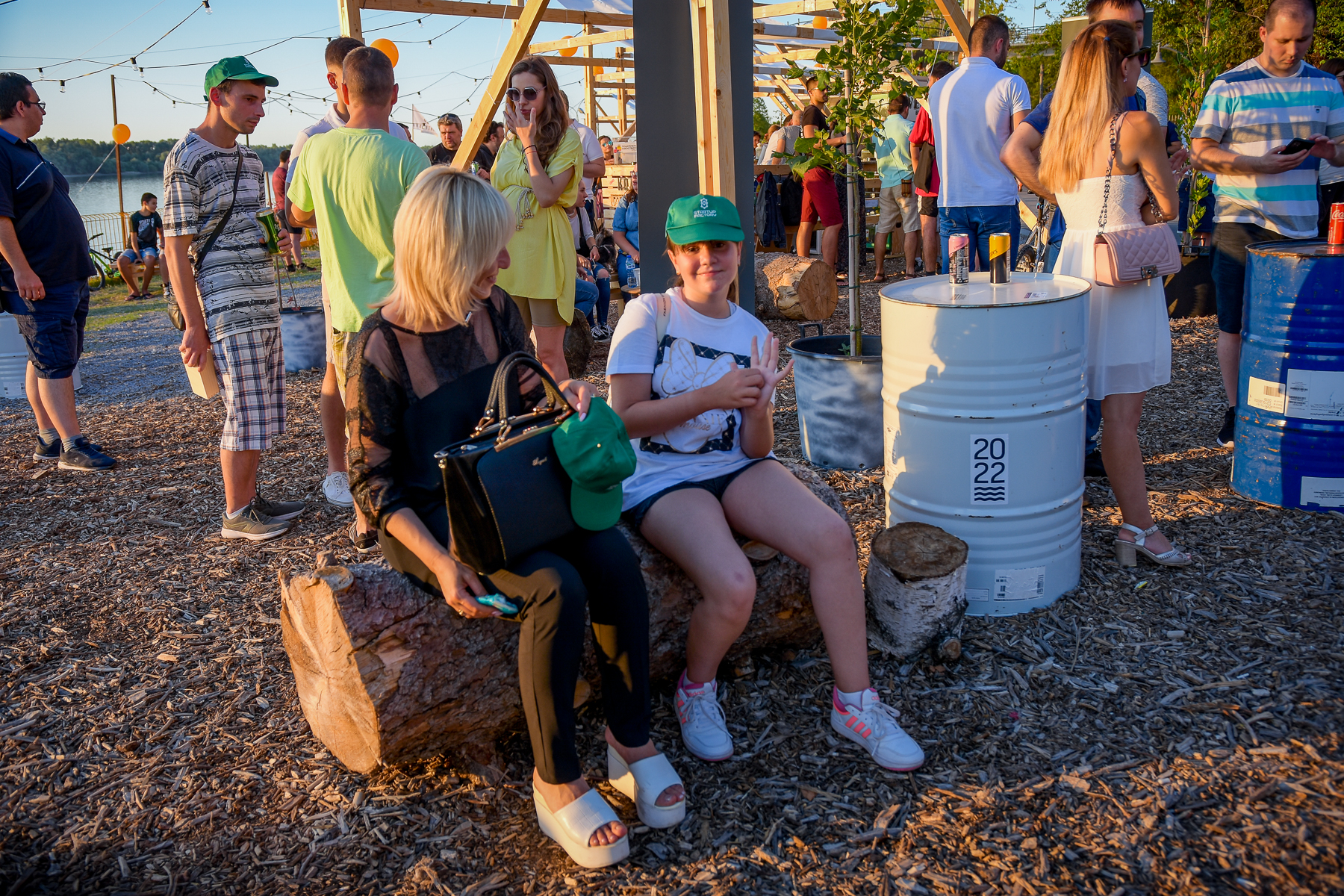


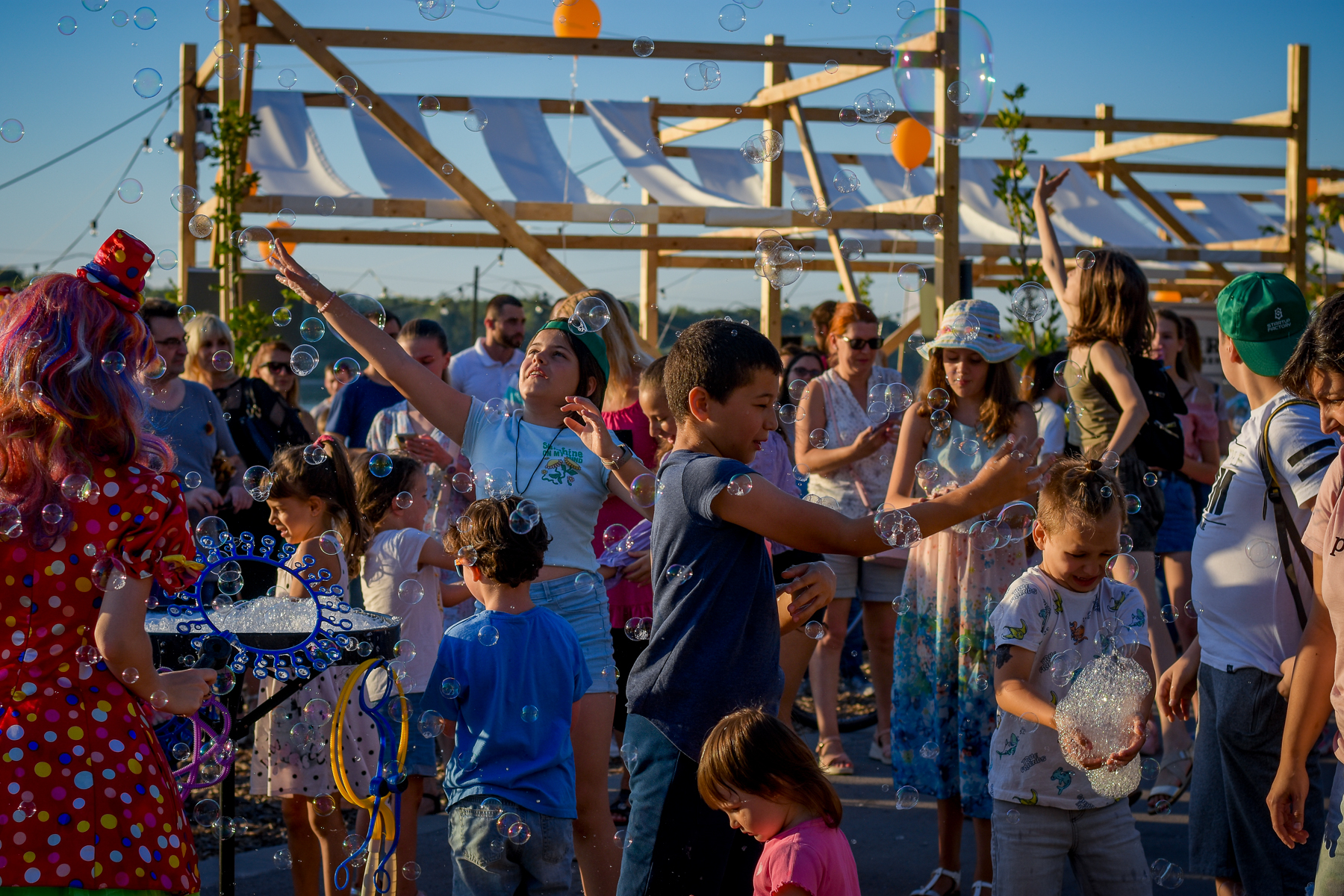 Photos: Startup Factory
Photos: Startup Factory
At the end of July and in early August, we ran a further initiative – an exhibition of placemaking projects reviving spaces by the Danube in other countries, including Serbia, Slovakia, Hungary, and Austria. We connected our local project in Ruse to our international Danube family, so to speak. The results were shown on-site and accompanied by an additional workshop for our group of students from vocational schools. This time, we took our collective imagination to the city scale, with a long walk along the coast to consider the possibilities of not just one site, but the overall relationship between the city and the river.


 The exhibition Design on the Danube.
The exhibition Design on the Danube.
Students pointed out issues that need to be addressed: poor lighting in some areas that creates an impression that the space is unsafe; lack of basic amenities like shade, and difficult access. Their suggestions for a new unified pedestrian route along the coast and incorporating nature into urban design will be vital as we continue our work in Ruse and advocate for these changes in city planning.
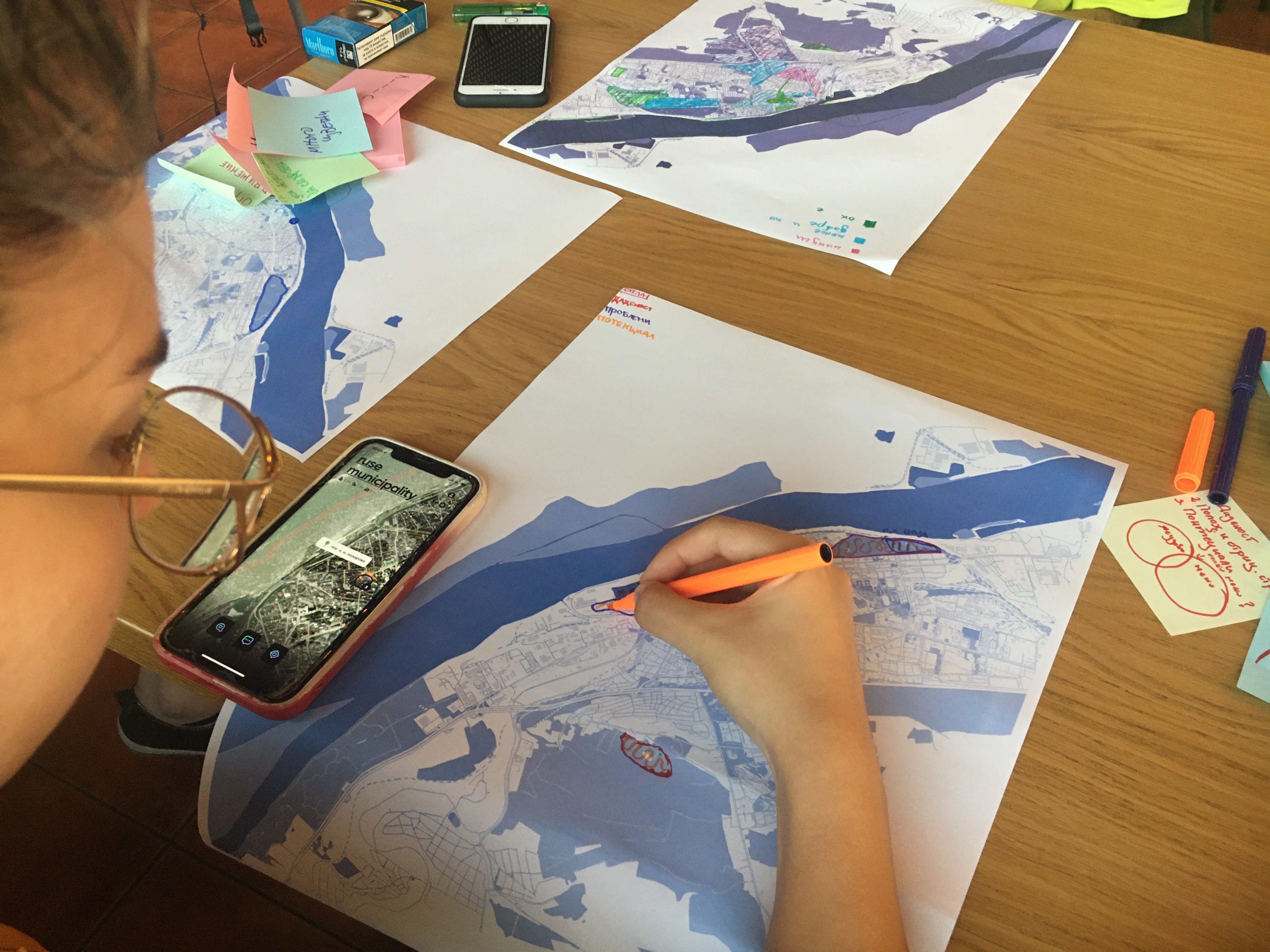
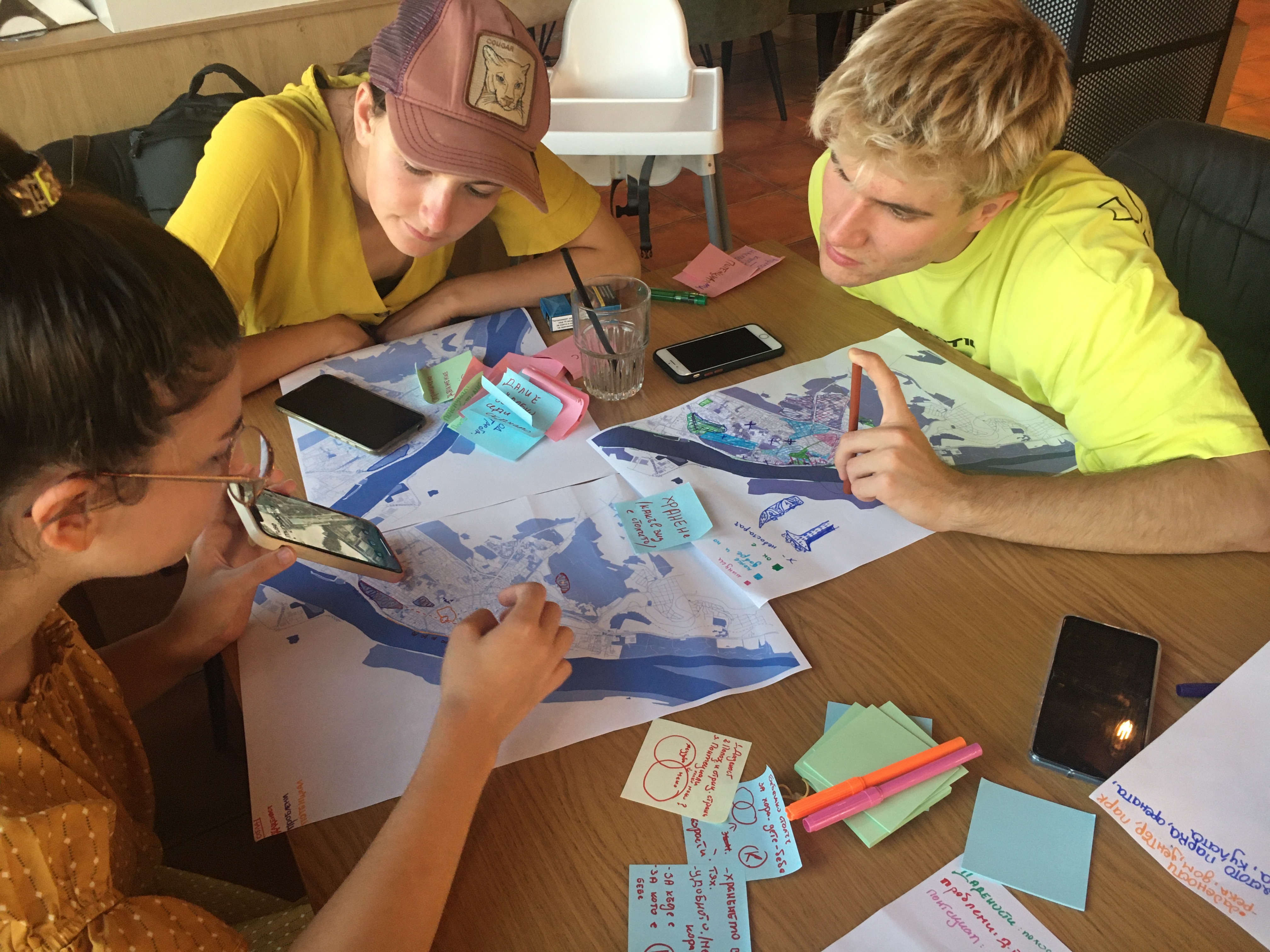
 Urban plannig workshop
Urban plannig workshop
Seven students attended the workshop, and one more helped install the exhibition of international examples on-site. So, we were able to gather around one-third of the group that took part in our main series of workshops in February. This showed the challenges of engaging our target group during the summer. We’ve learned that many of them work full-time during the break – whereas, during the school year, we were able to excuse absences from class. The students who did attend spent 4 hours engaging in depth with questions of how to open the city for people and nature.
The main feature of the summer by the Danube was music, including many performances by local musicians and bands. The site became extremely popular. We expected there would be interest, but it was stronger and more sustained than we would have thought.

People would gather there almost every evening for 4 full months, as we clearly hit upon an unmet need for younger people to be together in a place that feels their own. On the upside, this showed the huge potential for activated public spaces in Ruse where collective energy can be concentrated. Dozens of people shared that they finally had a place to go and gather in Ruse, and that the city felt more alive. Deputy Mayor for planning Magdalina Ilieva also agreed that young people in the city needed this, that she believes the initiative should continue next year, and that it could even help retain young people in the city – as one of the core problems Ruse is facing is youth outmigration.
Maintaining the space for 4 months was also useful experiment with many practical lessons in the complexities of creating public space. There were, of course, challenges. The place got recognition as a key part of Ruse’s alternative music scene. While this was amazing in some ways – it brought thousands of people there and made visible the strong local desire for active, especially youth-focused spaces by the river -- in other ways, it posed difficulties. One was some noise complaints from people living in two apartment blocks on the street level just above the space. Another was that the association of the space with a certain demographic meant concrete efforts needed to be made to diversify it, for example by holding more varied events, such as storytelling for kids and outdoor cinema.

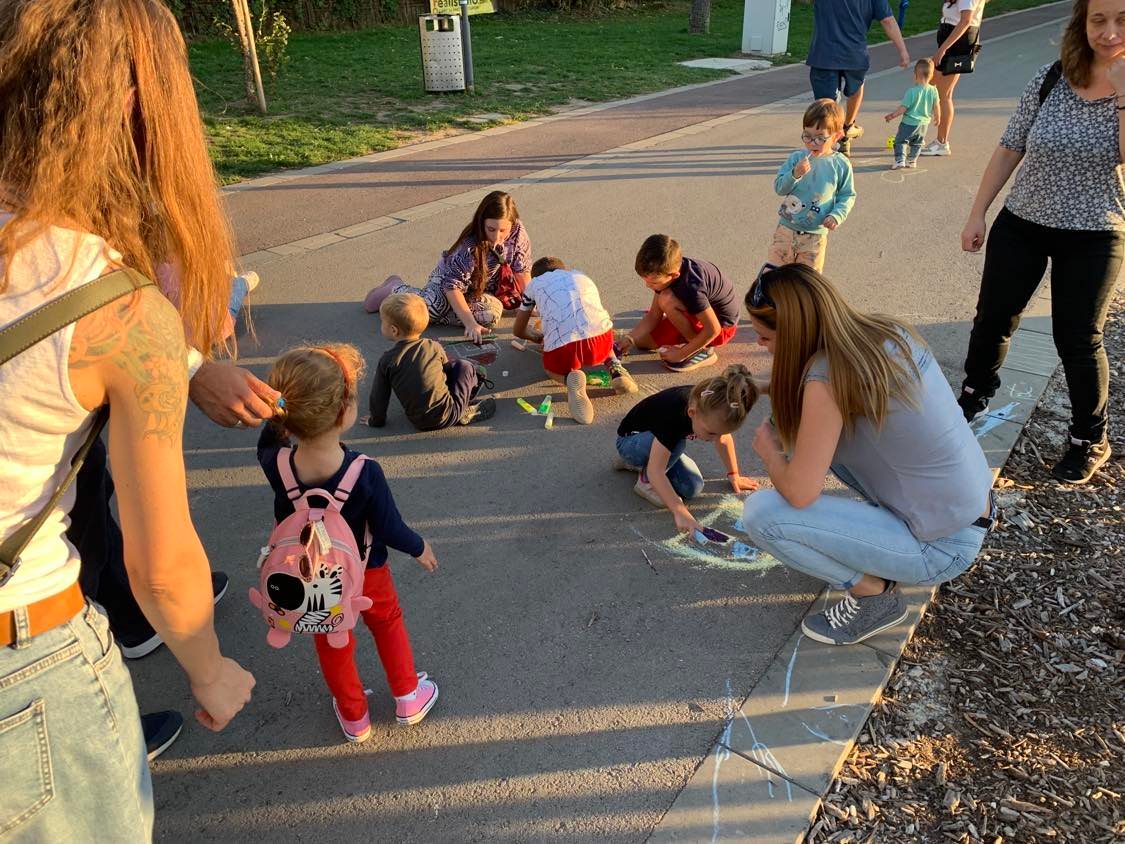
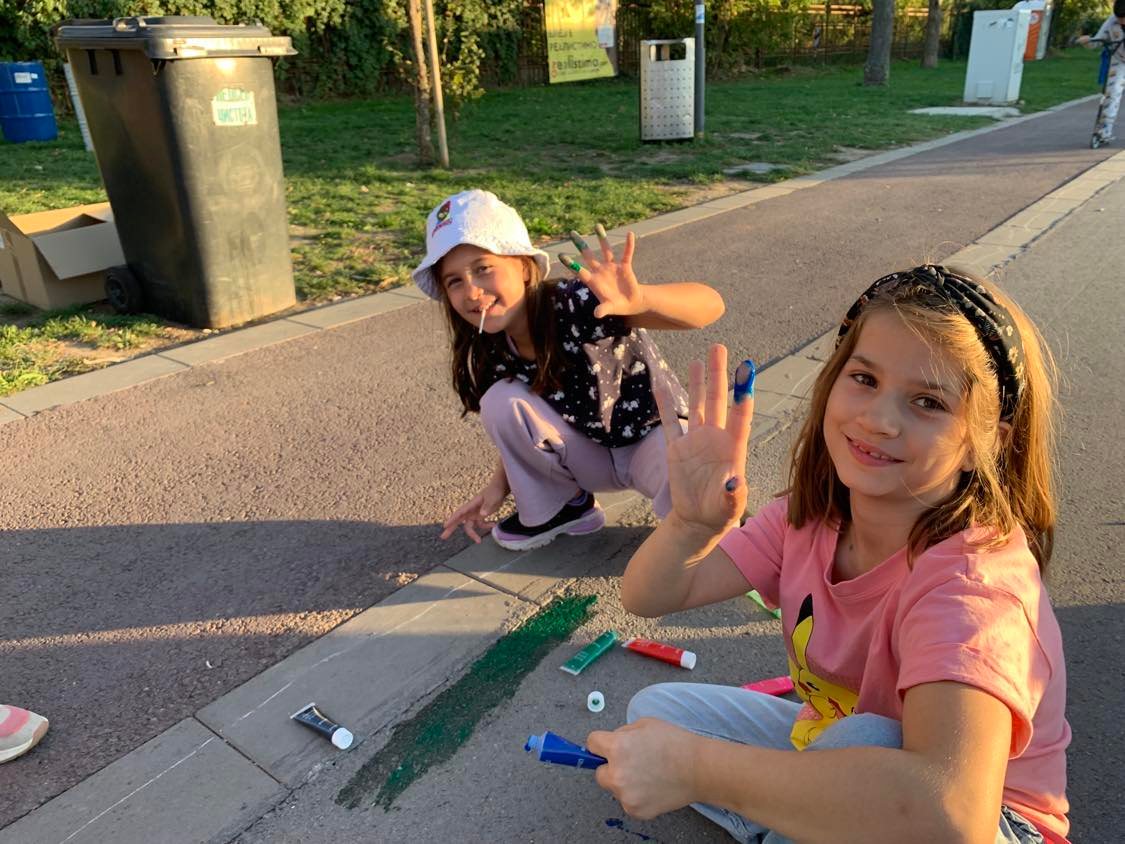

Movie screenings again proved extremely popular for all ages – something we already knew from our experience last year, when a movie night garnered the most attendance out of all events over the course of 4 days. However, scaling that is challenging, as each screening requires funds to rent equipment and to cover the movie rights.
So far, the result is that the experiment was highly successful, with sustained interest and positive feedback from a much larger number of young people in Ruse than our main target group, as well as from the municipality. At the same time, we have concluded that, as we continue the project, we will focus on more varied programming to balance out use of the space so that a disproportionate sense of belonging is not allocated towards just one social group. And, importantly, we will improve planning so that not only the creation of the space, but also its programming and management are done via inclusive methods. Within the scope of this project, we extensively planned the ideation and creation of the space, and that worked very well. The next area to focus on is its medium to longer-term use.
As a whole, the lessons learned demonstrate the value of temporary urban interventions to reveal what works and what can be improved on in the future. We believe this iterative approach to public space has a lot of potential and should be practiced more widely. Next year, we plan to continue the elements of the project that worked – including the collaborative design workshops, the on-site interventions, and events programming. In addition, now that we have proven that strong interest in shared space exists, we can also develop more refined and intentional processes for the ways it’s managed and used.
Finally, we concluded the season with our first cross-border event. Under the patronage of the liaison offices of the EU Parliament in Bulgaria and Romania, we gathered students and civil society actors from Ruse and Bucharest to share our successes so far and to also collect more ideas for the waterfront’s development.






International workshop and public presentation of the results in Ruse with guests from Bulgaria and Romania
Mixed groups of locals and those visiting the city for the first time generated creative solutions to Ruse’s challenges. Our experiential, collaborative workshop method again produced valuable ideas, from asking owners of disused riverside buildings to host students and artists, to inviting varied activities such as chess, fishing, picnic tables, and an artificial sand beach right in the middle of the city. These functions would cater to a different ages and groups. The only downside was that only students with high-level English skills from Ruse could participate due to the international nature of the event. On the other hand, people of various ages (16 to 45+) were able to collaborate – something we rarely see.
Once again, we were amazed by the potential of inviting people to create together and how, with a few techniques to stimulate imagination and dialogue, great solutions can arise in just a couple of hours. The results of the workshop were presented at a public forum with a deputy mayor and the municipality’s PR specialist in attendance in the audience, so the proposals, as well as the value of collaborative methods for finding local solutions reached them as well. We will build on that next year!
After an incredibly busy summer with workshops, an exhibition, cinema, lots of music, beautiful experiences, bonding, and new ideas and ambition for next year, we now conclude the Danube Design Lab 2022. It has been great to be part of the Civic Europe community! Thank you!
Creating a Shared Place by the Danube
Back in February, the students in our workshops developed proposals for what they would like to see on the Danube riverfront. After that, it was our turn to create a detailed architectural design and obtain permits. By 20 May, we were already on the river, building the new space together!
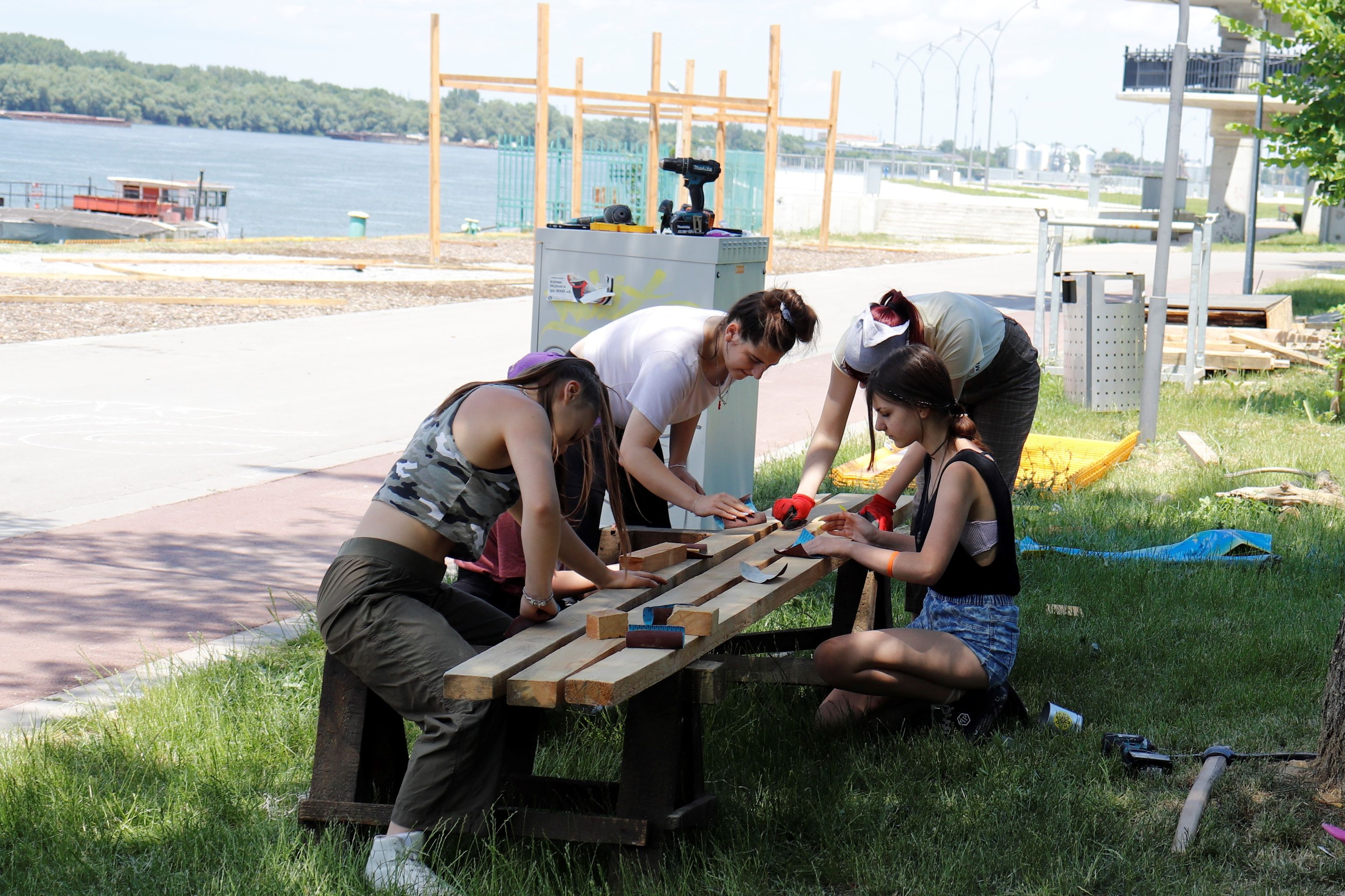
Students performing construction work on-site
The majority of the students took part in on-site work for a full week. They continued the collaborative spirit that started during the design workshops and formed flexible teams working on construction, decoration, and logistics. Around 20 citizen-volunteers who also joined in.
We all built the site with our own hands: cleaning up, laying rubble and wood chips on the ground, joining wood, constructing the stage, putting up lighting and shading. A volunteer artist painted graffiti on an entire wall facing our site, which some of the students had envisioned. Work went on from the morning till dark, with common meals and a lot of adjustments when something inevitably did not go according to plan.
The festival
A defining moment was the first evening of the opening events. A large number of people gathered – around twice the number that showed up for the festival's first edition last year.

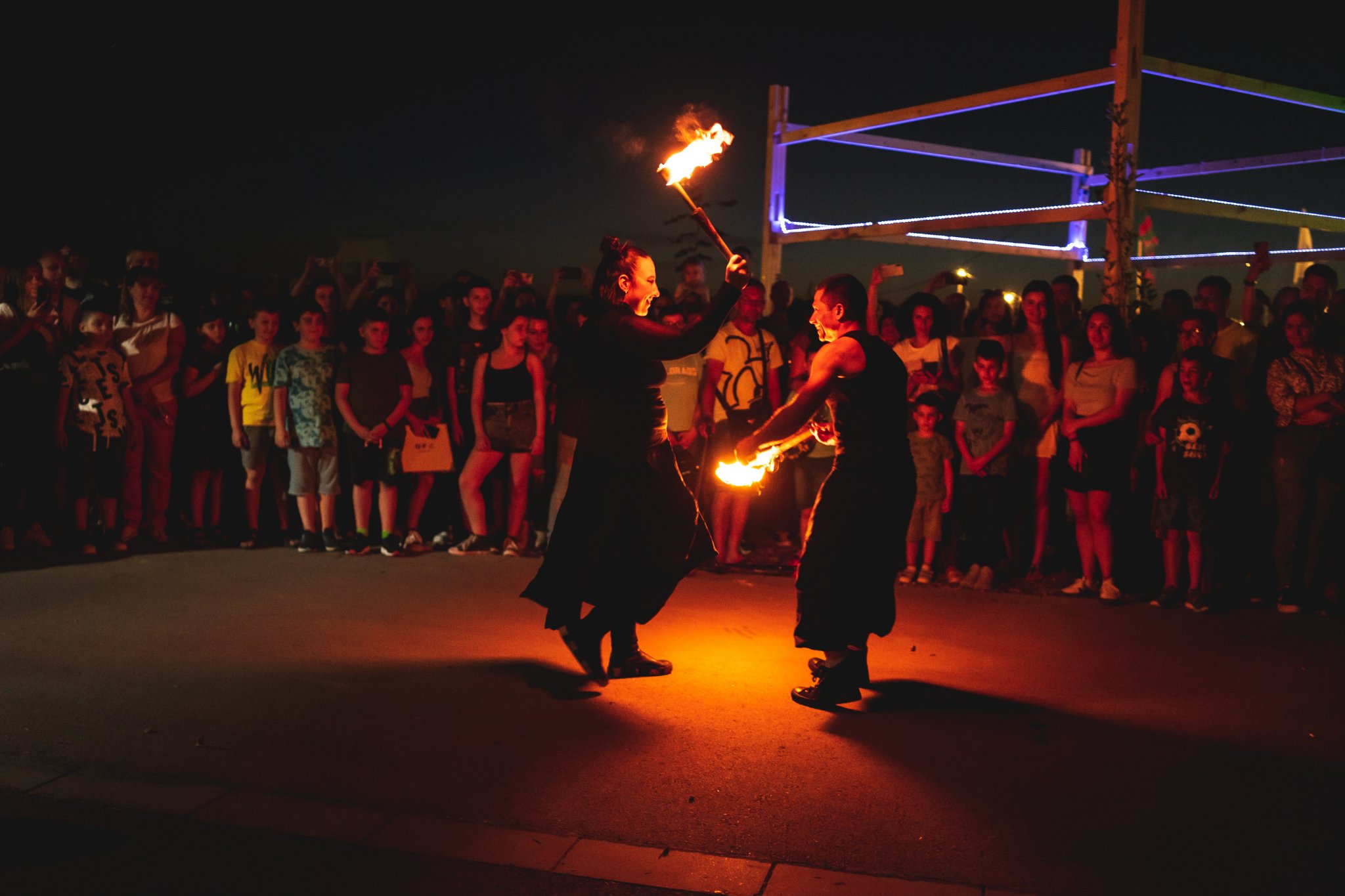
The festival's opening
Everyone was enjoying themselves, whether chilling in a hammock or enjoying a glass of elderflower syrup at the bar, sitting by the Danube, or dancing to the music.
Around sunset, we gathered on stage to say thanks: the organizers of the initiative and the students in front of us. Everyone got a big round of applause. It was amazing to see the students beaming and proud of what they’ve achieved.

The Collective and the students who took part in designing and building the place at the festival's opening
Celebrations continued that evening and throughout the weekend with fire dancing, fun sports challenges and lots of music. A large group of students was on-site at all times. They talked informally with the organizers from The Collective about their experiences in school, frustrations, and hopes. This was now their place to gather and think big.
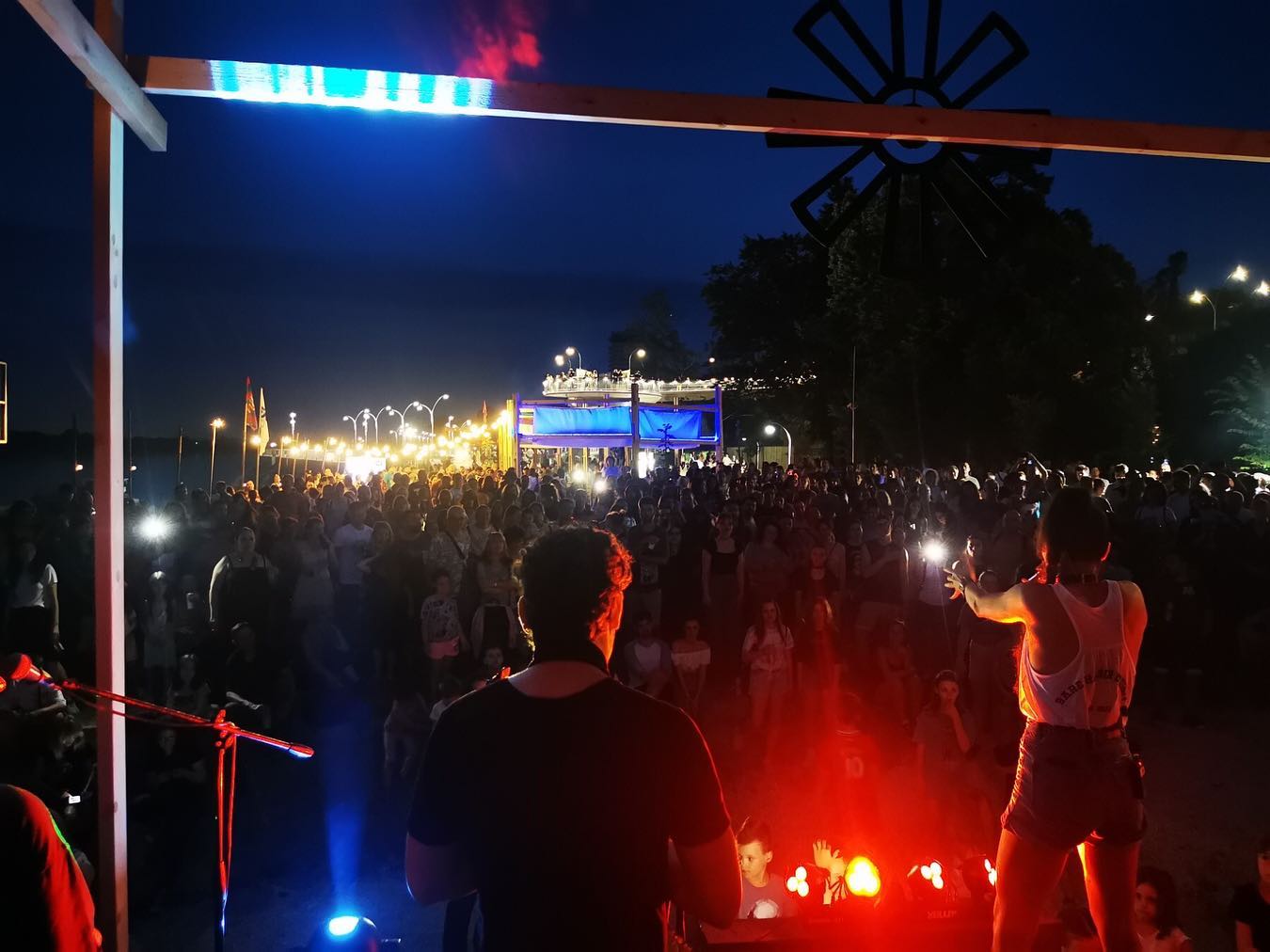
A concert on the second day of the festival
Events are ongoing during the whole summer and will balance the interests of a larger public with programming geared towards the students – like a week of free workshops in digital artmaking in the beginning of July.
After the opening festivities ended, we hosted a big dinner for students to celebrate all we’ve achieved. They are now part of our network and our colleagues. We look forward to continuing to work with them on transforming public space in Ruse and making it more interactive, exciting, and open for citizens.

Students gathered for a dinner outing on the day after the festival
An added twist to the story this year was that on the night of 6 June, just a week after the opening, a severe storm hit Ruse and there was lots of damage across town.
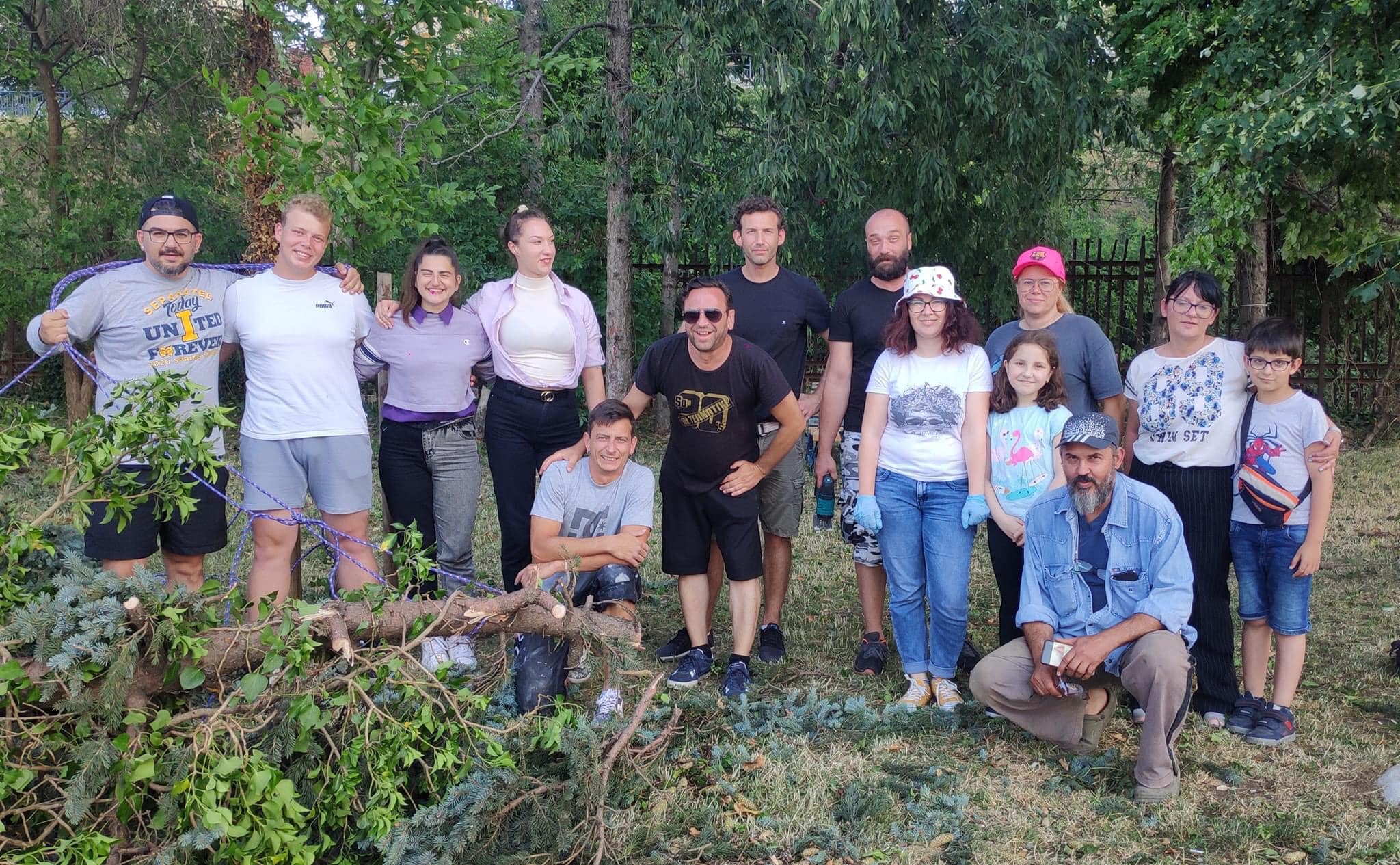 The volunteer crew that fixed up the place immediately after the storm
The volunteer crew that fixed up the place immediately after the storm
Dozens of trees had fallen and roofs of buildings were blown off. Our site also sustained damage, although it was minimal by comparison. Volunteers self-organized immediately and a group involving a few of the students cleaned and fixed up the place. After extra repairs the following day, it is in good shape and open to the public again. This was an example of shared ownership and belonging – people now cared about the palce and wanted to maintain and improve it.
We hope our project has been inspiring. Turns out that, if vocational school students, architects/ designers, and local leaders get together, great things can happen. We’d love it if you try it out in your town as well! Feel free to reach out if you have any questions.
What Do We Want in Our City? Designing Together
Over 7 days of workshops and activities in February, students got together to imagine how they would like to change their city.
Students developed proposals and practiced fundraising strategies in a role-playing activity. They discussed their ideas with the mayor and the municipality's PR official, and in the end got feedback from representatives of local businesses, media, and public and civic organisations.
Activities in our creative workspace in the High School of Apparel were interspersed with site visits to do spatial research and test out ideas. We had lots of pizza, games, and informal conversations. Friendships were formed and the teamwork continued later, in May, when the majority of the students took part in building the placemaking intervention based on their proposals.
If you could do anything…
In the first 3-day series of workshops, students thought more broadly about the kinds of changes they would like to see in their hometown. The different teams’ projects included machines providing food to stray animals, a network of satellite parks in different neighborhoods, and a restaurant on the Danube that the students would operate as a social venture.
Teamwork: Desislava (in the purple hoodie), the municipality's PR officer, takes part in design work with the students.
The students practiced ways to promote and present their ideas. In a role-playing exercise, they also ‘applied’ for funding to public institutions and companies. Students talked with the city’s (real) major and PR officer about the kinds of changes they would like to see. The officials explained what channels for feedback and requests are available to citizens. The PR officer said she is open to meetings with the students, and two of them did set up a follow-up meeting to present their ideas for a local park.
We also had visits from inspiring local figures, like the manager of the Europe Direct center in Ruse, who informed students about further opportunities that they were not aware of. As a result, two students from two different schools signed up for a train trip across Europe funded by the EU. Representatives of the local NGO Startup Factory presented their youth programs and arranged a meeting with Petya Boneva, a graduate from the High School of Apparel who now has a design business in Ruse and works with international customers.
The mayor (in front) during his work with the students.
The mayor, the principal of the High School of Apparel (in black) and the students pose for a spontaneous photo-op during the mayor's participation.
Our workshop mentors who worked closely with the students at all times included two architects, a landscape architect, an interior designer, a builder, and an architectural historian turned project manager – through collaborating with them, students also learned what traditional and non-traditional paths are open to them.
We also had time for fun, including circle dance activities and the hugely popular game of “Ninja.”
On visits to our worksite on the Danube and walks around town, students shared the ways they experience their city and their thoughts about why the urban environment is the way it is. Then, in the next round of workshops, we proceeded to more concrete actions to change it.
Designing change
During the second, 4-day series of activities, the teams focused on the site chosen for our placemaking intervention.
The different teams had bold proposals for this site, including floating installations on the water, opening up a pathway to the river, integrating a nearby building by decorating it with graffiti and attaching the stage to it, and reorienting the whole design towards the pedestrian walkway to draw in more people. These proposals made their way into the built design - with the exception of the floating pieces, which would have required additional permits but remain to be realized in future years.
Students again presented their work-in-progress to peers and got continuous feedback. During a final presentation and celebration, they also got support from a range of guests: a journalist from Radio Ruse, an executive from a major local company, and leaders from civic and arts organizations – including СъГраждани (Co-citizens), Gradored, Lindy Hop Ruse, Stand Art, and others.
Proud project creators
Students took the leading role, presenting their ideas for the city, and the local civic leaders acted as a supportive expert audience.
Students from a total of 7 local high schools joined us this year. A few took part thanks to referrals from friends: for example, a student from the shipbuilding vocational school came along with her friend from the construction school. And two students from the economics vocational school joined because our social media campaign reached them.
We had the most participation from the construction high school, which validated our assumption back in January that on-site visits to schools, and in particular classroom visits, were the most effective in encouraging students to take part.
Overall, it was a fruitful gathering of students, officials, and active citizens. What were we able to build together as a result of the ideation and design workshops? You can see that in our next post…
A Quest in Ruse’s Schools: Reaching Participants by All Means Possible
The first step of implementing our project was reaching our target group of students. This turned out to be a bit of a challenge because of restrictions under the Omicron wave. We had to adapt to the situation in Ruse in January and find more creative ways to reach students and encourage them to take part.
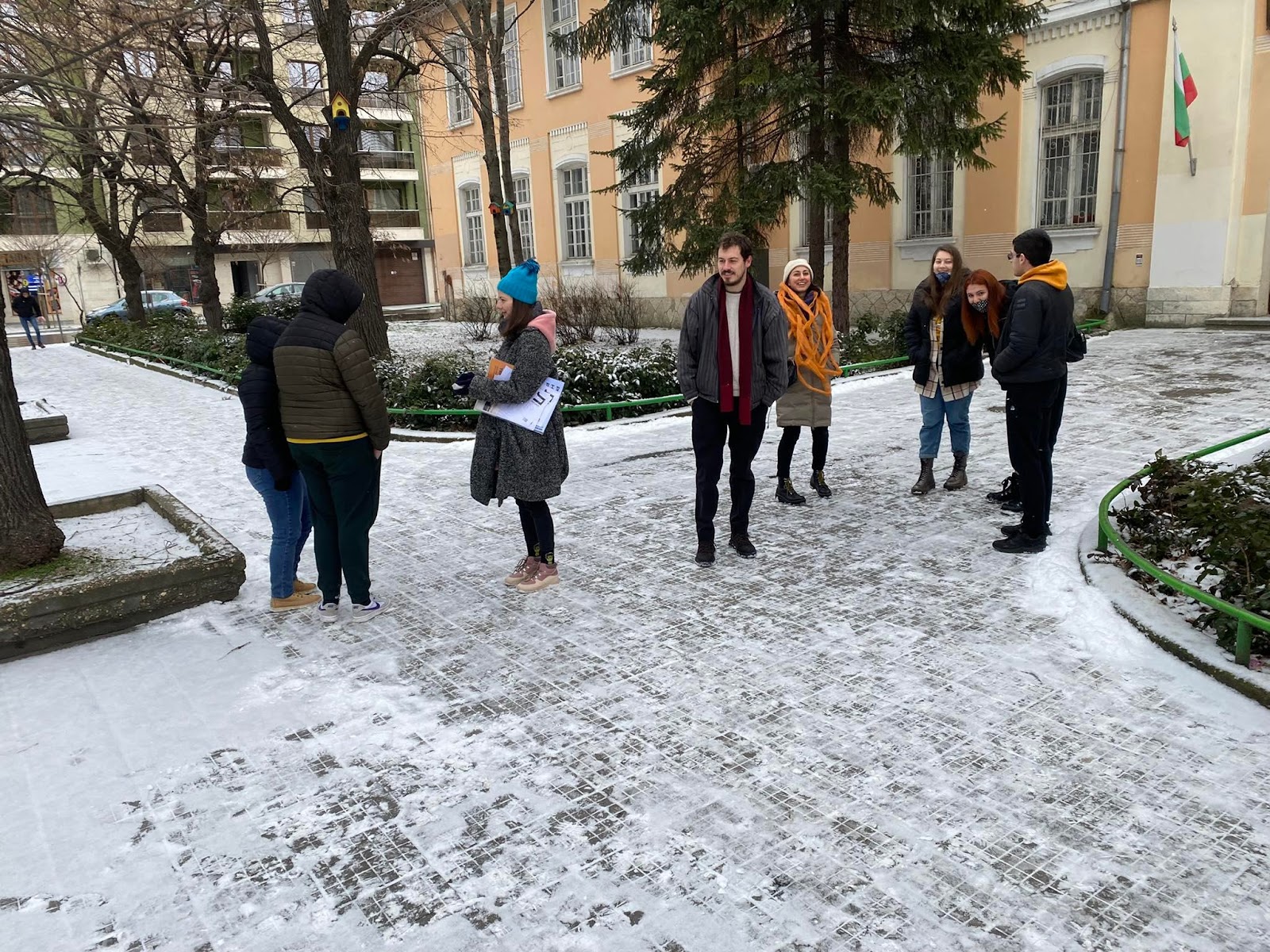
Talking with students in front of the main entrance of the Professional High School for Woodworking and Interior Architecture "Joseph Vondrak" in Ruse.
Our original idea involved presenting the Danube Design Lab in high school classrooms. We wanted to connect with students, especially the ones less engaged in class and less likely to sign up for extracurricular activities. We aimed to show them the Design Lab could be for them.
Conditions changed and we had to revise the plan slightly, and to adapt to each of the specific schools depending on their internal policies.
One of the school principals, understandably, said that we could not enter the building due to covid concerns. In that case, we met students in front of the school gate during a break between classes, and also on the sports grounds where some students hang out. We were able to get some engagement that way and to spread the word.
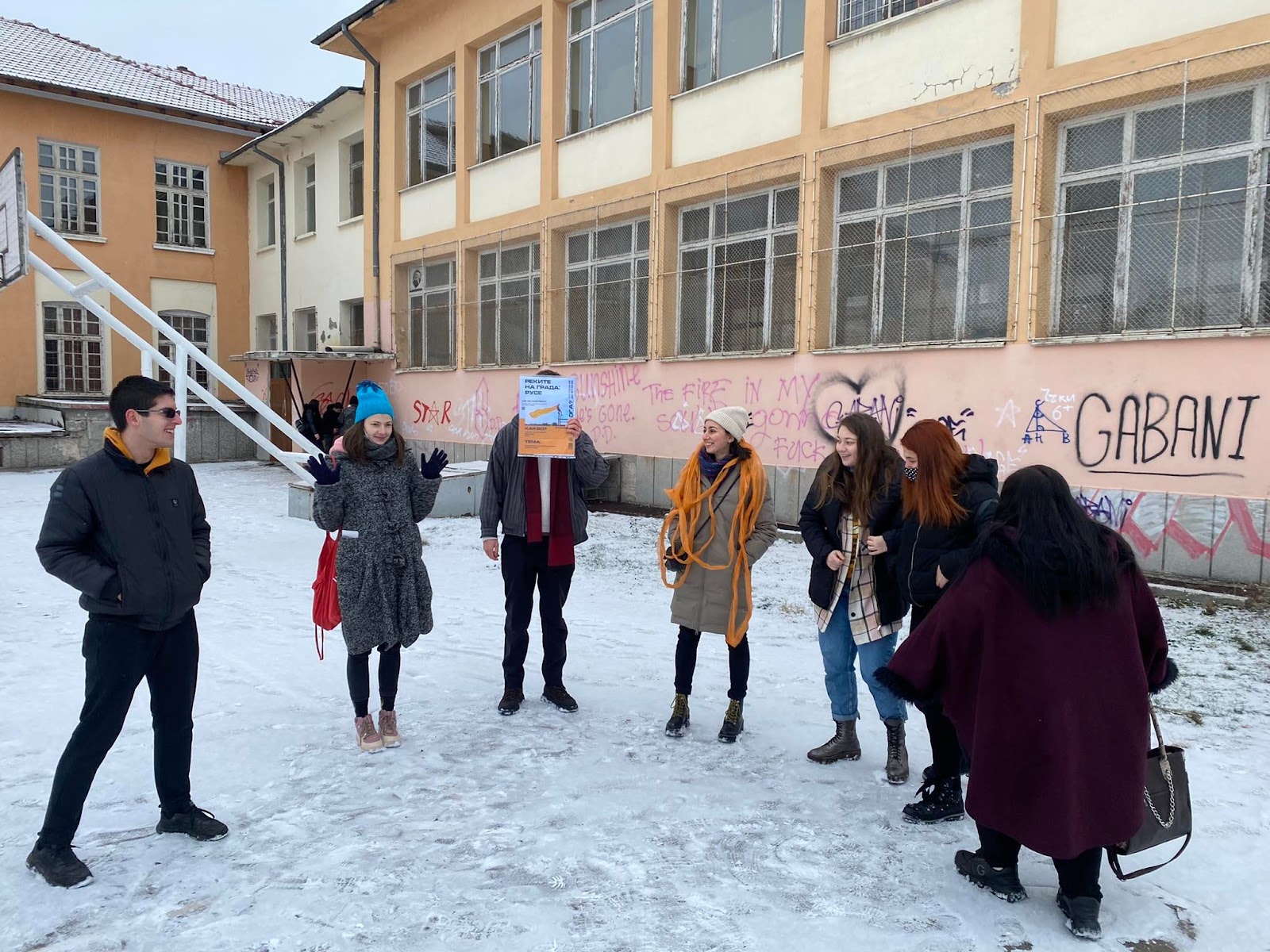
Engaging students on the sports grounds behind the Woodworking School.
Over half of students at this school were learning remotely from home. For them, as well as for the teachers, we held an online meeting to generate some excitement around the Danube Design Lab. We invited a student who participated in our design workshop last year, to share his experience. This meeting had partial success: teachers engaged, asked questions, and encouraged students to take part; students themselves engaged only by turning on cameras and answering whether or not they had heart of the Design Lab already. Thankfully, we did get applications from this school and students who actively took part in the Design Lab workshops later on.

An online meeting for students and teachers at the Professional High School for Woodworking and Interior Architecture "Joseph Vondrak" during a school-wide free period. Georgi, a student who participated last year (in the bright red shirt and glasses), is encouraging fellow students to take part.
At the other schools, we also had to adapt our programming and activities to respond to the situation. We had to try and reach each student where they are, as best we could.
At the Professional High School for Apparel "Nedka Ivan Lazarova", we were able to meet some students at a gathering in the school auditorium, with safety measures in place. We presented the initiative and briefly talkеd with individual students afterwards. A few filled out application forms right there and then. It was a more controlled environment, but it sparked some individual connections in addition to teachers popularizing the initiative among students.
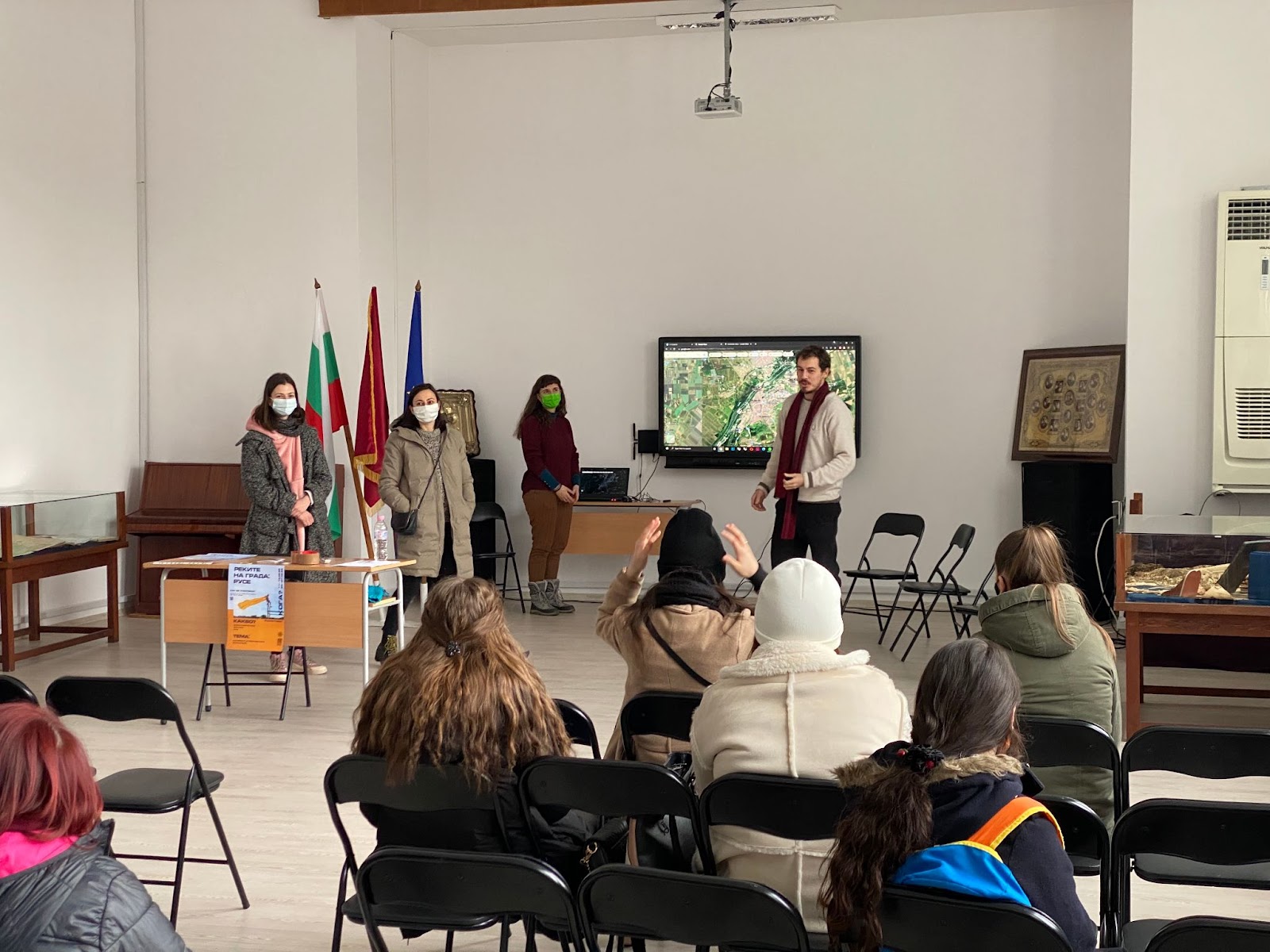
Presenting the Danube Design Lab in an auditorium at the Professional High School for Apparel "Nedka Ivan Lazarova".
In the Professional High School for Construction, Architecture and Geodesy "Penyo Penev", we were able to fulfill our original plan to enter classrooms. We talked to students during and in-between classes, answered questions, and gave them a sense of the vibe at our design workshops and events. Direct engagement in classrooms did, as we expected, generate the most interest and meaningful connections. We had a few teaching moments when students made jokes about the idea or asked critical questions. We turned those moments around and showed our approach: informal, creative, and very open to unusual ideas. We did get to speak to a few of those young people at the back of the class who may not otherwise have considered extracurricular or civic activities.

Talking with students in a classroom at the Professional High School for Construction, Architecture and Geodesy "Penyo Penev".
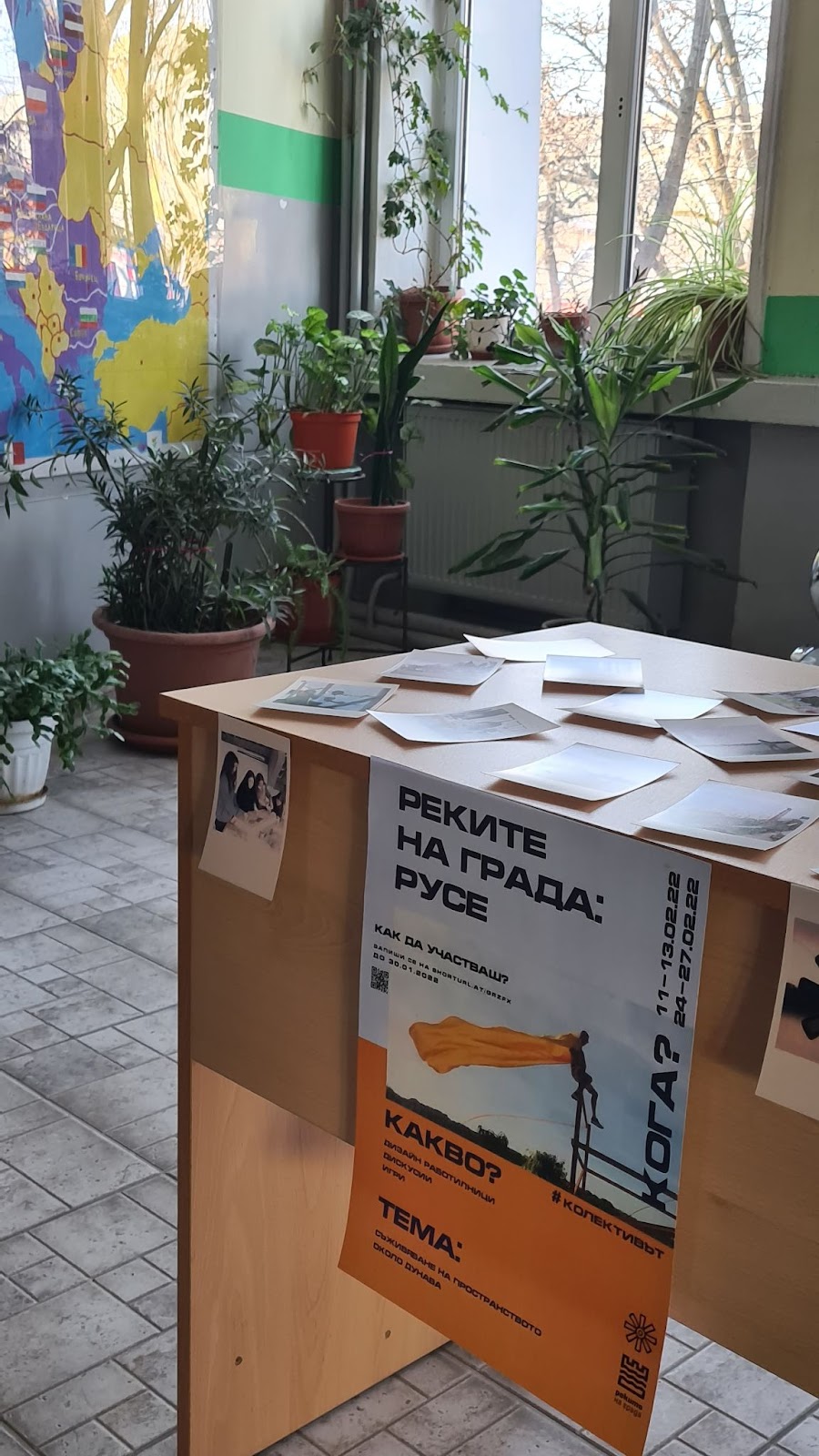
The Danube Design Lab booth in the same school.
We also set up a little booth in the hallway near the school’s entrance, where we talked to students passing on their way in or out. In the end, we got significant participation from the construction high school, more than from the other schools. This showss that our original idea of direct engagement in schools, in students' everyday environment, works well.
Meanwhile, we also boosted a call for participation on social media. A post promoting the initiative reached over 26,000 people total and 10,600 people specifically in the Ruse area, where it ran as a targeted paid post - a significant number in a city of around 120,000 residents (according to the latest census). We have observed that Rusentsi are willing to share and spread the word when something inspiring is going on in town, so news of initiatives travels quickly.
A result of the online campaign was that we got two students from an additional vocational school - the economy high school. One student also got a friend from the shipbuilding vocational high school to take part. That way, the total number of vocational schools included in the project rose to 5 (or nearly half of the 12 vocational high schools in the town). 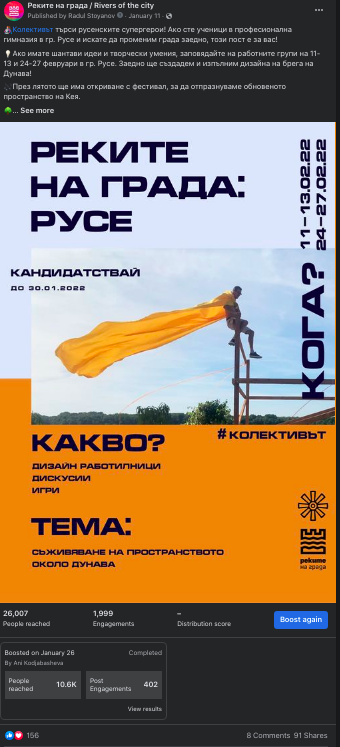
The boosted Facebook post calling students to participate, with 26,000 people reached in total and nearly 2,000 engagements.
In summary, the search for participants was more unpredictable and varied than we thought. Thankfully, we were able to engage students, to expand our reach a bit, and to conduct our series of activities in-person as planned -- we’ll tell you more about that in a future post. Stay tuned!
You can follow us at facebook.com/kolektiv.bg.
A Danube community takes shape
The Danube Design Lab brings high school students and architecture/design professionals together with local officials to create new public space on the Danube. Young people's imagination and the town's civic resources can revive a neglected place on the riverfront so it can become a hub for social and cultural change.
This is a design/urbanism project, but in reality it is about people. We aim to get more locals engaged in the way their common areas look and function. Urban space is our medium, and a more inclusive, active society is the goal.
To get there, we have a lot of work to do with stakeholders in town to ensure wider support and participation. In this initial phase of the project, we are coordinating with officials; involving schools in promoting the idea; recruiting students; and developing more partnerships with organizations whose input can help us activate the new space.
Getting locals on board – officials and students
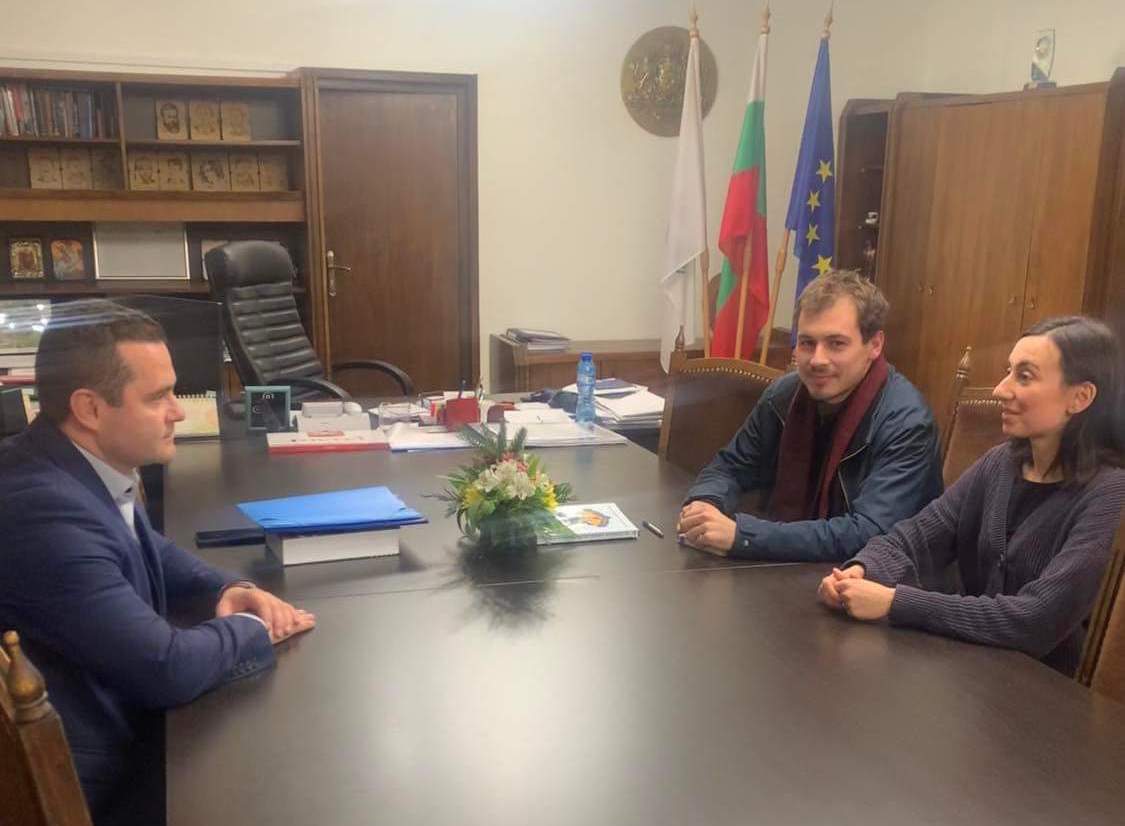
We started with meetings with the mayor and chief architect of Ruse. Both of them affirmed their commitment to the project and to engaging with students. Participation and recognition from these stakeholders is key, as it means we'll be able to move beyond the idea phase and begin impactful change in the urban environment. Dialogue between officials and youth will hopefully enable lasting change.
Next, we spoke with the principals of the three main schools we are working with – the Professional High School for Construction, Architecture and Geodesy; the Professional High School for Apparel; and the Professional High School for Woodworking and Interior Architecture. In addition, we talked with the principal of the National School of the Arts in Ruse. The four principals will help disseminate information about the project to students, who are our main target group. They will also assist us in reaching students directly.
With the school principals, we discussed possibilities about visiting in person to present the project to students. While the schools support the idea, we could not put anything on the calendar yet because of the quickly changing Coronavirus situation. In January, we would either visit schools or devise alternative ways to engage students.
Meanwhile, our talented designer, Gergana Ivanova Ilieva, has prepared promotional materials to invite young people to take part. Check out our cool banner below:

Expanding partnerships
Finally, we had productive meetings and dialogue with civic organizations, whose input will be helpful once the physical transformation of the space is completed. These organizations can continue to engage students and other social groups, and will ensure the place we create is lively and inclusive.
Among those who have already expressed a commitment to take part are:
- Ruse Go – community sports and volunteer activities
- StandArt – an association of performance arts professionals and activists
- Lindy Hop Ruse – a dance group
- Зелени посланици (“Green Ambassadors”) – promoting ecological living through educational and arts workshops
- Arenata – DIY sports and collaborative games in unusual outdoor locations
- Gradored – local history
- ВиЖна – improvisational theater
- Tourist association “Prista” – youth outdoor activities
- Zalata – yoga lessons open to the community
- Europe Direct Ruse – informational center on EU initiatives
- Tutrakan Tourism – open cooking workshop
Conversations are underway with other potential collaborators as well. We are continuing to connect with local groups and to enlist partners so we can accelerate urban transformation through wider civic participation.
The work of building community will continue after the holidays. In February, it will be time for hands-on activities during our workshops with students.
With shifting regulations because of the ongoing pandemic, things are a bit uncertain, but the work of stitching together community and designing a shared space will continue, even if we need to be flexible.
If you like the project, stay tuned here and on our social media pages: https://www.facebook.com/kolektiv.bg
Write comment